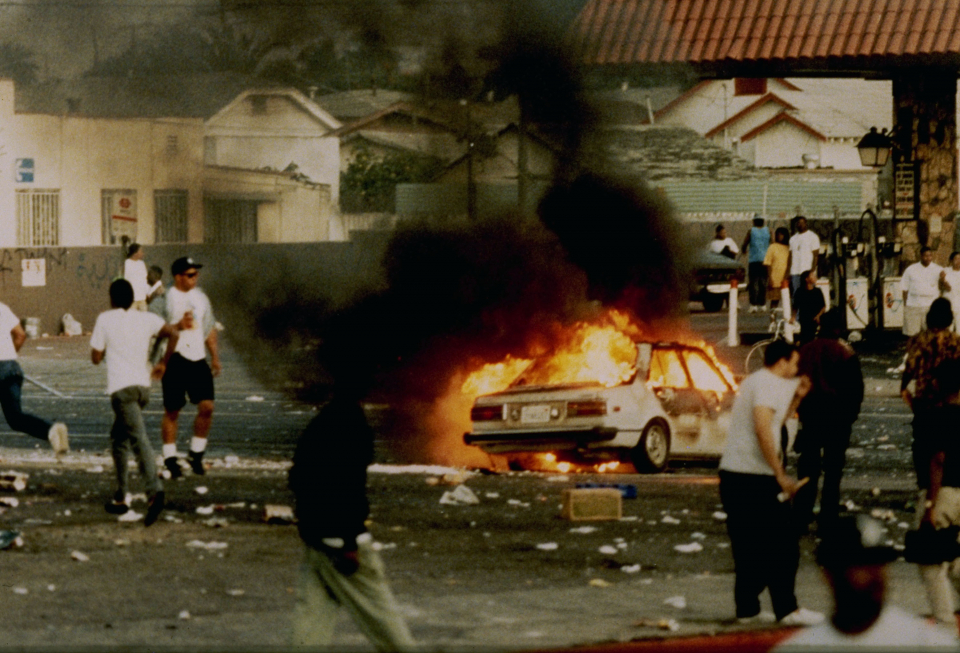
The video of Rodney King being beaten on the side of the road in Los Angeles 25 years ago helped to usher in a new sense of awareness about the injustices that had been consistent in the Black community for years. The beating of Rodney King combined with the murder of 15-year-old Latasha Harlins along with the acquittal of the officers and the release of the woman who killed Harlins bubbled over into an uprising that will never be forgotten. These uprisings have left an indelible mark on the history of America and its people.
National Geographic‘s documentary “LA 92” provides an unencumbered perspective on the events of that time and ties the ’92 uprising into the Watts riots of 1965. The events are eerily similar and beg to question if our society has changed at all.
We spoke with the directors of the documentary, Dan Lindsay, and TJ Martin, about their work on this documentary and what they ultimately expect people to leave with after seeing it.
Talk about what ultimately led you to take on this project. Why did you approach it in the way that you did?
Dan Lindsay: The 25th anniversary of the unrest in Los Angeles sparked the project. The inherent issues of the project are things that speak to myself and TJ. It’s something we have always been interested in. For obvious reasons, it felt really relevant to what is happening today. This is an event that happened in a town that we called home for many years now and it was something that we didn’t have a ton of knowledge about.
TJ Martin: Knowing that there are going to be seven other projects that are exploring the same chapter in American history, we also saw an opportunity to explore it in a different light. We took a more new and unique approach that would hopefully create a new and unique dialogue around race, class and injustice so we are not going through the same hamster wheel having the same conversation and still experiencing the same social problem. That was one of the reasons for the creative approach we took. We didn’t want everything to be filtered through the voices and lens of “experts” that are deconstructing the event. We didn’t want to take a journalist approach, but rather create an immersive and visceral experience for the viewer, hopefully, to create a new perspective on the events themselves.
What surprised you most during the making of this documentary?
DL: We are aware that history repeats itself. It does so much that it’s a cliche. I think what surprised me was the specificity of the similarities between Watts and the 92 civil unrest, down to the number of days it lasted and the fact that it started from an incident with a traffic cop.
What do you think has changed?
TM: There is a gentleman in the film that was interviewed during the Watts civil unrest that we revisit in the film. He says something to the effect of “I don’t think it will ever change, it may not look like this but it will never change.” Honestly I think the facade has changed but I don’t think the realities have changed specifically for disenfranchised communities. When I say disenfranchised I’m also speaking of immigrants and those from a lower social economic class. Collectively as a society, the realities in which those communities exist in are not the same of the dominant culture. They just aren’t. They experience more injustice on a consistent basis. The only thing that has really changed is the democratization of cellphones having cameras that gives us more material to actually be face to face with those realities. Now, has anything really changed? Not necessarily.
DL: One of the inherent contradictions of the history of America is we seemingly do make progress at times. There are these measurable things that we look at that say life is better in some ways but still nothing changes. It was this cognitive dissonance that we wanted to explore this in the film and is why we put the film together in a way so that it evokes that constant sense of cognitive dissonance. How can we make progress in some ways and seem to go backward in others?

Do you think that the film will add any fire to the political and racial narratives that exist now?
DL: My hope would be that it wouldn’t add fire in a negative way. I think if it were to inspire people or embolden people to have more conversation and become more aware of our collective history it would be a good thing. If it were to inspire more polarization it would be a bad thing. I think the film explores that idea. What is the fueling of the fire? If you have no voice or you feel your voice is not being heard, what other means do you have? I guess it remains to be seen.
TM: If one considers invoking some sense of empathy fueling the fire, hopefully, it does that. I don’t know if it will but the hope is that we continue to have these conversations with a better understanding of what a variety of different communities go through. We had a private screening in Los Angeles and a gentleman who grew up in Watts and was a child when the ’65 riots happened and lived through the ’92 civil unrest was troubled at the idea that Korean merchants were exploiting the residents South Central because they wouldn’t reinvest in South Central. After seeing the film he felt like he got a deeper sense of emotional empathy for the Korean American experience and he never actually connected to that experience until watching the film. In having that experience that informs the way he moves forward with that conversation. Does that make sense?
That makes a lot of sense and the film affected me in that same way. So many of those stories were never told. Now just to shift gears a little bit, it was so awesome to see Maxine Waters on the front line 25 years ago just like she is now. Was that something you did on purpose?
TM: I think it speaks more to the idea that you can’t plan these things and that these issues are constant. We didn’t plan for her to rise up and be in the news as much as she is. We also constructed this film thinking that Donald Trump was not going to be president of the United States. It’s interesting to see Mrs. Waters on the news so much. That moment when she is standing in front of the post office is the image of a leader who has standing in the community. Her address in DC the morning after the first day of the unrest was just as powerful when she says, “We have no relationship with the president.”
How long did it take for the project to come together?
DL: it was nine months of editing. I think we crammed two years into that nine months; it’s been a really intense experience.
Has there been any pushback during the screenings? How have people responded so far?
DL: The most common response is that it sobers people. We haven’t gotten any kind of pushback.
TM: Like Dan said the most common response is that it’s sobering. I also think that the other really common experience is that people are swimming in their head and swimming in their own feelings not quite knowing what the next step is. I’m OK with that, knowing that you will be stewing in those feelings and thoughts and eventually you will come to a place where you would want to take action.
National Geographic’s “LA 92” premieres Sunday, April 30 at 9 p.m. EST.














